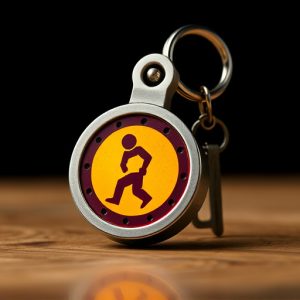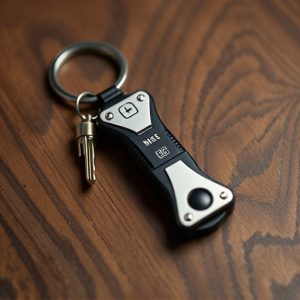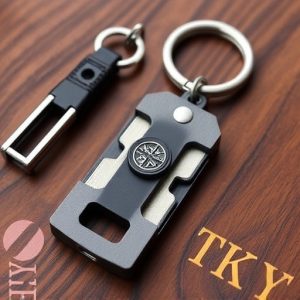Keychain Alarm: Security Features & Legal Aspects of Panic Buttons
The Keychain Alarm with Panic Button System is a compact, portable personal safety device featuring…….
The Keychain Alarm with Panic Button System is a compact, portable personal safety device featuring a high-decibel alarm, GPS tracking, and a panic button for immediate emergency assistance. Important considerations include establishing a robust Prohibited Keychain Weapons List to prevent misuse of such devices while balancing personal security and freedom. Despite its small size, the keychain alarm is an effective deterrent and communication tool, ideal for solo travelers or high-risk areas, provided users understand local laws regarding prohibited weapons. Regular testing and proper implementation practices ensure reliable performance without legal issues.
In today’s safety-conscious world, personal protection is paramount. One innovative solution gaining traction is the keychain alarm with panic button system—a compact yet powerful tool designed to enhance individual security. This article explores the multifaceted aspects of these devices, from their basic functionality and advantages to legal considerations and the critical need for a comprehensive Prohibited Keychain Weapons List. Understanding these key elements can empower individuals to make informed choices about personal safety.
- Understanding the Keychain Alarm with Panic Button System
- The Need for a Prohibited Keychain Weapons List
- Components and Functionality of the Device
- Advantages and Disadvantages of Using a Keychain Alarm
- Legal Considerations and Implementation Guidelines
Understanding the Keychain Alarm with Panic Button System
The Keychain Alarm with Panic Button System is a compact and innovative personal safety device designed to offer immediate assistance in emergency situations. This small yet powerful tool fits comfortably on a keychain, making it easily portable and accessible. When activated, it triggers an alarm that can deter attackers and alert nearby bystanders or emergency services. The panic button feature allows users to quickly send out a distress signal with just one press, ensuring swift response times.
Understanding the key components of this system is essential. The device typically includes a high-decibel alarm, a GPS module for location tracking, and a panic button. Some models also have LED flashlights for added visibility during emergencies. Additionally, users can register their personal details with the accompanying app, which can aid emergency services in identifying and contacting them promptly. This technology is particularly valuable for individuals who frequently find themselves in isolated or high-risk areas, such as those on late-night walks or commuting alone. Knowing how to activate the alarm and utilize its features could be a matter of life and death, especially when faced with unexpected dangers.
The Need for a Prohibited Keychain Weapons List
In today’s digital era, personal safety has become a paramount concern for many individuals, prompting the development of innovative solutions like the keychain alarm with panic button system. However, before such devices can effectively serve their purpose, it’s crucial to address a critical aspect: the need for a prohibited keychain weapons list. This list serves as a regulatory framework that defines what types of miniature weapons are prohibited from being attached to keychains, ensuring that these seemingly innocuous items do not fall into the wrong hands or be used maliciously.
Without a comprehensive and regularly updated prohibited keychain weapons list, it becomes challenging to prevent unauthorized individuals from carrying potentially dangerous tools in their pockets or bags. Such a list must consider the balance between personal security and civilian freedom, ensuring that only devices designed for genuine self-defense purposes are permitted while prohibiting those that could be easily concealed and misused. This proactive approach is essential to maintaining public safety and fostering a secure environment for all.
Components and Functionality of the Device
The keychain alarm with a panic button system is a compact personal safety device designed to fit comfortably on your keys. Its core components include a high-decibel alarm, a sensitive motion sensor, and a panic button. When activated, the alarm sounds loudly, drawing attention and potentially deterring potential assailants. The motion sensor detects unexpected movements, triggering the alarm if it senses a possible threat.
The panic button is a straightforward yet powerful feature that allows users to send out an emergency signal quickly. It connects to a monitoring center or pre-selected contacts, providing immediate assistance during dangerous situations. This device is particularly useful for individuals who frequently travel alone or those living in areas with high crime rates. Knowing that a simple press of a button can summon help offers a sense of security and peace of mind, especially when considering the Prohibited Keychain Weapons List, ensuring only non-lethal self-defense tools are carried.
Advantages and Disadvantages of Using a Keychain Alarm
Using a keychain alarm with a panic button system offers several advantages, especially for personal safety. Firstly, it’s an easy-to-carry self-defense tool that can be accessed quickly in emergencies. These alarms are compact and attachable to keys, making them discreet yet reliable. In case of distress, a simple press of the panic button triggers a loud alarm, often with flashing lights, to attract attention and deter potential attackers. This feature is particularly useful in dark or noisy environments where yelling might not be heard. Additionally, many keychain alarms have GPS tracking capabilities, allowing users to share their location with emergency contacts.
Despite these benefits, there are also some disadvantages to consider. One key concern is that certain areas or establishments prohibit the use of keychain weapons due to safety and security regulations. The Prohibited Keychain Weapons List varies across regions, and users must be aware of local laws to avoid legal issues. Moreover, while the alarm can raise awareness, it might not always guarantee physical protection. False alarms could lead to unnecessary consequences, and the effectiveness depends on bystanders or authorities responding promptly. As with any personal safety device, regular testing and familiarity with its features are essential to ensure its reliability when needed.
Legal Considerations and Implementation Guidelines
In many regions, the legal considerations surrounding keychain alarms with panic buttons are stringent due to their potential as prohibited keychain weapons. These laws vary significantly based on location but generally aim to prevent devices that could be used as offensive tools from being easily accessible. Understanding these regulations is crucial before implementing such a system. Keychain alarm manufacturers must ensure their products do not fall into categories listed in the Prohibited Keychain Weapons List, which often includes items designed for self-defense or capable of causing harm.
When integrating a keychain alarm with a panic button into an organization’s safety strategy, it’s essential to follow implementation guidelines. These include proper training for staff on how and when to activate the device, clear communication protocols for alerting emergency services, and regular maintenance checks to ensure the device’s functionality. Compliance with local laws and best practices ensures that the system serves its intended purpose of enhancing security without causing unnecessary legal issues or concern.
The keychain alarm with panic button system offers a compact, portable solution for personal safety. By integrating a robust alarm mechanism and immediate panic response feature into a convenient keychain accessory, individuals can enhance their security while addressing the pressing need for a prohibited keychain weapons list. While these devices provide several advantages, such as ease of use and discreetness, legal considerations and clear implementation guidelines are essential to ensure responsible adoption and effectiveness in deterring unauthorized weapon possession.


